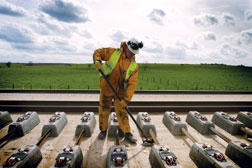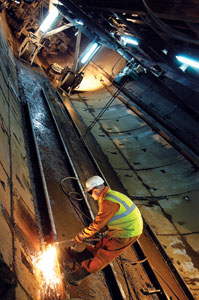
ADIF High-speed track is proliferating between France and Spain thanks largely to private financing.
|
Both countries continue to make major investments in systems that, within a decade, will allow uninterrupted high-speed travel from London’s newly restored St. Pancras terminal to the Mediterranean coast 2,250 km away.
Spain is due to open two new lines this month, while trouble with a tunnel in Barcelona delayed a third launch. France early next year will invite bids for the 300-km Tours to Bordeaux line, the country’s first privately financed railroad.
Last month’s final breakthrough breached the Pyrenees mountains, a massive obstacle between the two systems. The tunnels will carry a new 44.5-km line from Figueras, Spain, to Perpignan, France, with a common gauge for high-speed track.
Initially, the link will cut two hours off the Barcelona to Toulouse journey on conventional French track. Later, it will feed directly into France’s high-speed network via a planned line through Nîmes.

ADIF The 9.9-m-diameter twin tunnels through the Pyrenees is mostly through good rock.
|
Breaching the Pyrenees was tougher than expected, with poor rock impeding tunnel-boring machiness used on its twin drives. But the joint venture of Spain’s Dragados S.A. and Eiffage T.P., Paris, still aims to open on time, says senior technical manager Jean-Philippe Miquel-Elcano. The joint venture has a build-operate-transfer agreement, and is bound by a lump-sum turnkey contract valued at $1.4 billion.
The project is Europe’s second privately financed cross-border railroad job after the Channel Tunnel. French and Spanish government ministers signed the 50-year contract in early 2004 with T.P. Ferro.TPF is equally owned by Eiffage Group, Paris, and ACS Group, the Madrid-based parent of Dragados.
TPF closed its financing package in early 2005. It included bank loans of $775 million and a similar sum in subsidies from the Spanish government and European Union.
Nearly 90% of the tunnel lies in France, but for logistical reasons, both TBMs set off just over the border at La Junquera, close to the 17th-century Bellegarde fort. Knowing a major fault lay ahead, the contractor bought two 9.9-m-dia double-shield TBMs.
According to the TBMs’ German maker, Herrenknecht A.G., Schwanau, the double shield allows lining segments to be placed at the rear while the cutter advances, in sites where the rock is good. Each machine has its cutter head on a front shield, which telescopes out from a rear shield. Rear gripper shoes hold the TBM against the tunnel wall, making activities at the machine’s back and front independent of each other.
 |
| GAZAIGNES |
In fault zones where rock is too weak for side grippers, the TBM reverts to conventional operation. Cutters can then only be moved forward by hydraulic rams pushing against the completed lining at rear, preventing simultaneous segment erection.
Rock along the Pyrenees route is mainly sound granite, granodiorite and gneiss, notes Miquel-Elcano. But in the fault area, the TBMs “had to bore in very mixed ground with... (a) face made partly of crushed schist and partly of strong diorite rock.”
Launched in June and September 2005, the TBMs labored through the fault zone during summer last year. One took three months to cross and the other five. The first TBM home broke through on Oct. 1 and the second was greeted in France by ministers from both governments at a ceremony late last month.
Both tunnels are now fully lined by 40-cm-thick precast concrete segments with waterproof gaskets. Set 20 m apart, the twin bores are linked with cross passages every 400 m plus four equipment galleries spaced 1.6 km apart.
| PLANNED SPANISH RAIL NETWORKS |
| Madrid-Segovia-Valladolid line: 179.5 km.Work began 2001. |
| Antequera-Malaga line: 55 km.Work began 2002. |
| Tarragona-Barcelona line: 87 km.Work began 2001. |
| Madrid-Valencia-Alicante-Murcia line: 914 km.Work began 2002. |
| Barcelona-Figueres line: 131 km.Work began 2003. |
| Orense-Santiago line: 87.5 km.Work began 2005. |
| Bobadilla-Granada line: 109 km.Work began 2007. |
| Vitoria-Bilbao-San Sebastian line: 175 km.Work began 2006. |
| Navalmoral de la Mata-Caceres-Merida-Badajoz line: 278 km. TBA. |
| Valladolid-Vena de Banos-Burgos-Vitoria line: In planning. |
| Venta de Banos-Leon-Asturia line: In planning. |
| Sources: ADIF |
To make up for lost time, the contractor has opened a second front to allow for track installation and equipment testing from both portals. The line will be ready to operate on Feb. 17, 2009, as initially planned, says Miquel-Elcano. On the tunnel approaches, “civil works are completed, and technical buildings are ready for equipment installation,” he says.
The main snag in France was securing environmental permits, notes Miquel-Elcano. In Spain, the contractor had to redesign foundations of the River Muga viaduct for unforeseen ground conditions. The line includes 11 viaducts totaling 3.3 km.
| + click to enlarge |
 |
Elsewhere in Spain, the state-owned railroad infrastructure company ADIF hit the skids two months ago on plans to open an a section of the line on the 804-km Madrid- to-the Pyrenees route. Ground settlement at a tunnel for the 87-km-long line from Tarragona damaged a commuter station in the Bellvitge district of Barcelona, wreaking havoc on traffic and ADIF’s schedule.
The incident did nothing to reassure administrators of Barcelona’s Sagrada Família Cathedral. In October they went to court seeking an injunction against ADIF’s intention to tunnel close to the landmark building’s foundation piles. Church officials sought proof of the building’s safety and still await a ruling, says a spokeswoman. ADIF had been due to award a contract soon for the 5.6-km tunnel. Running between Sants and La Sagrera stations. The tunnel will complete the cross-city connection.
Despite setbacks, ADIF still plans to celebrate two new high-speed openings this month: the new 180-km Madrid-Segovia-Valladolid line and the 55-km stretch from...
n an historically fitting coincidence, crews achieved the second of two tunnel breakthroughs last month near a 17th-century French fort built to repel Spanish armies in the Pyrenees. Now the friendly nations are linked by the 8.2-kilometer-long Pertús (Perthus) high-speed rail tunnels.
Post a comment to this article
Report Abusive Comment